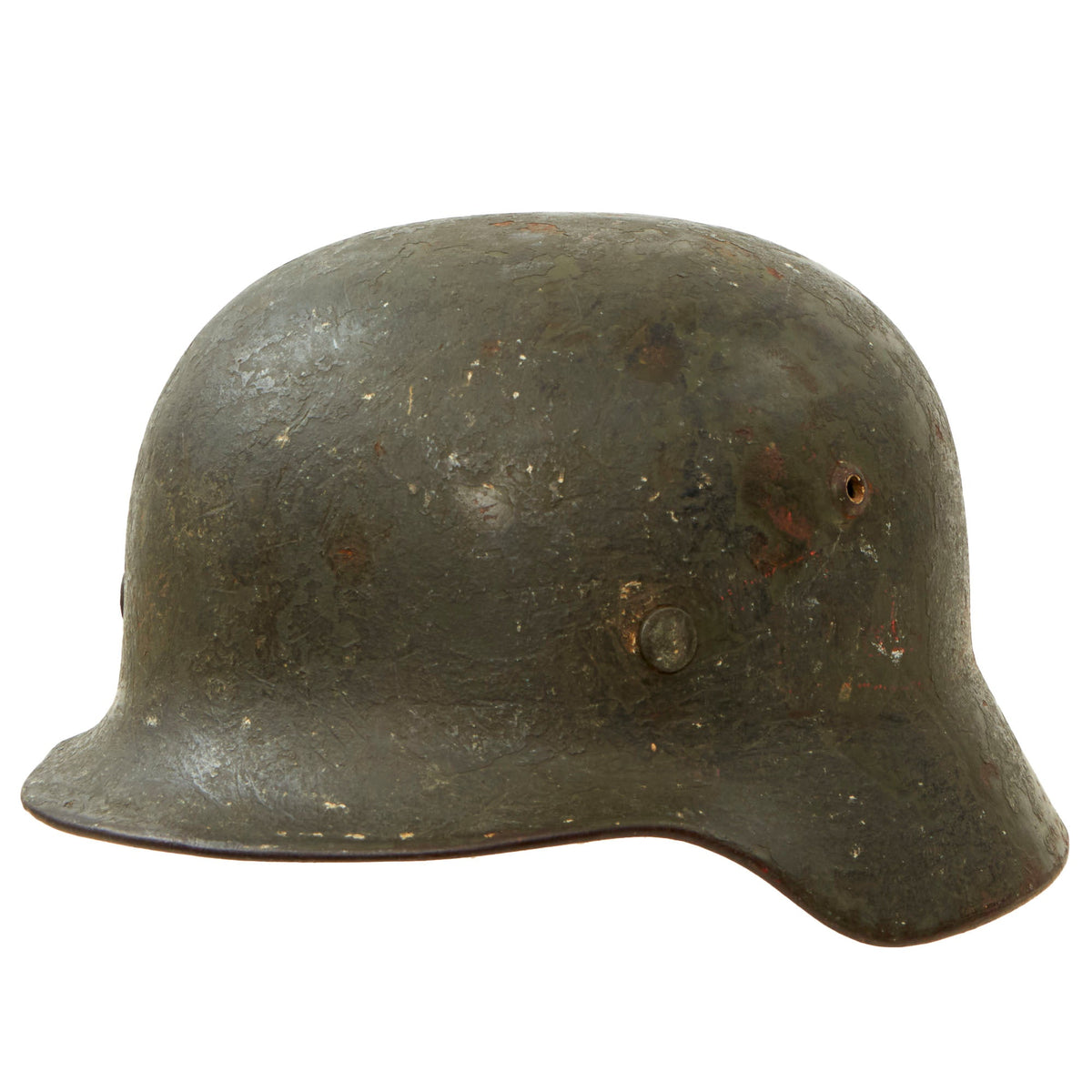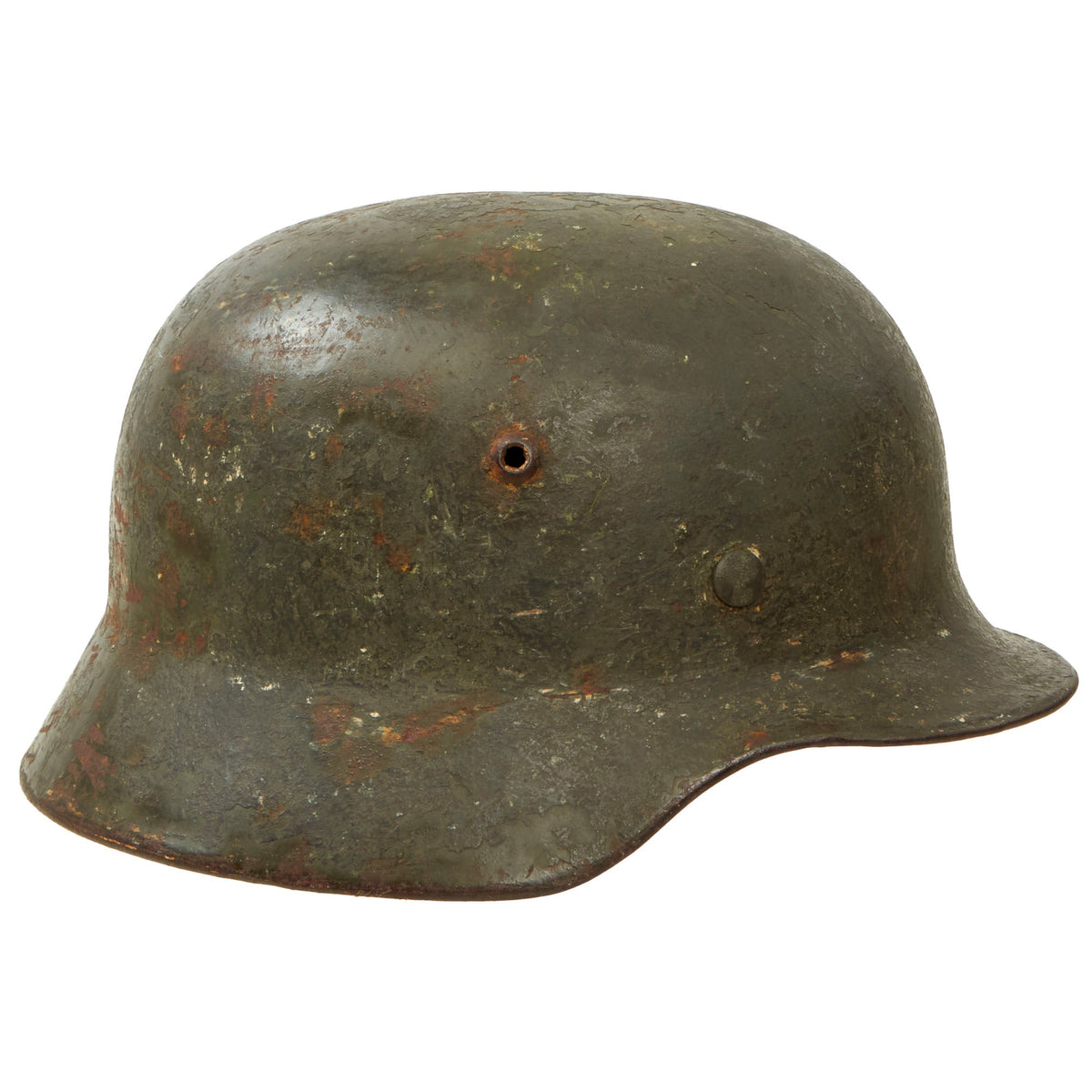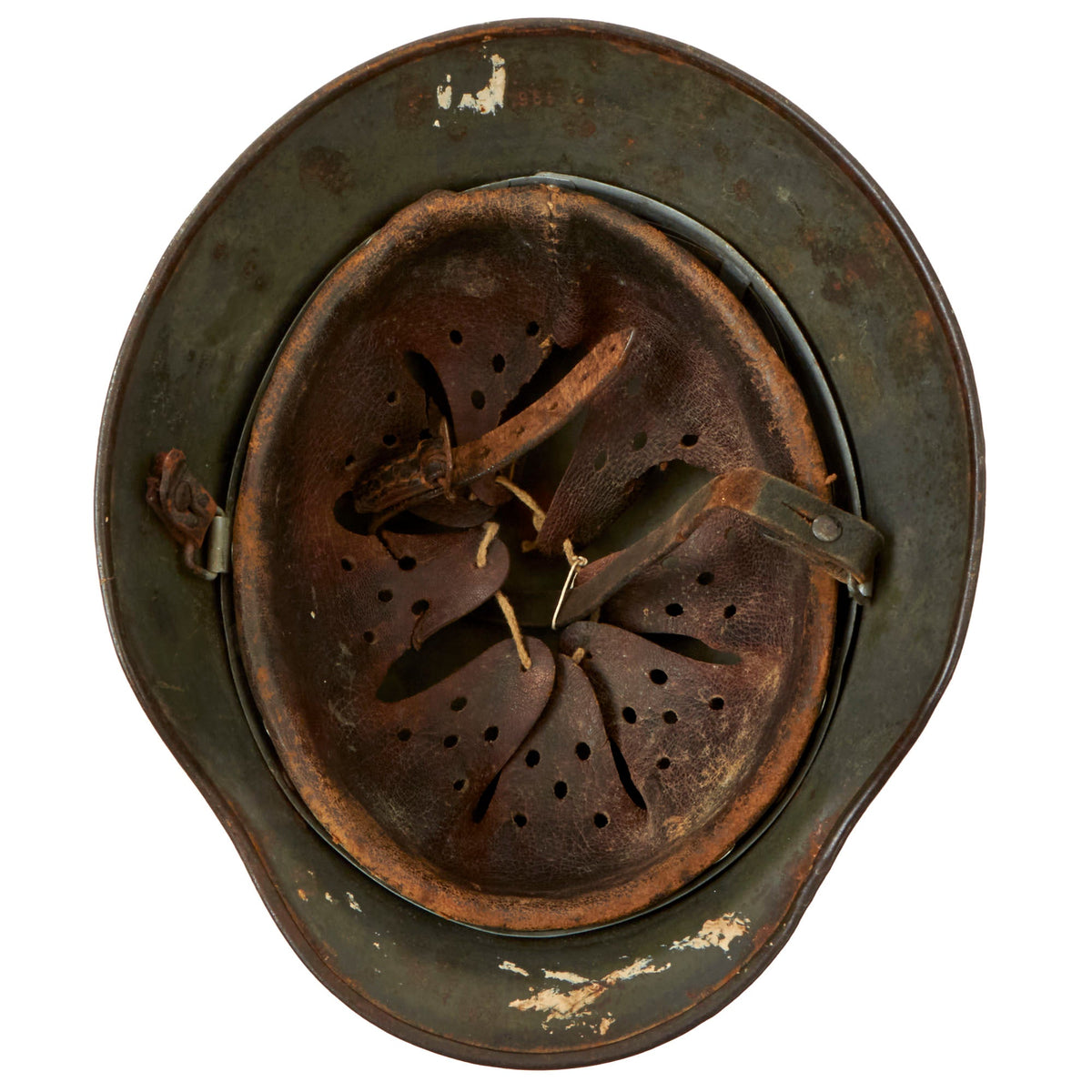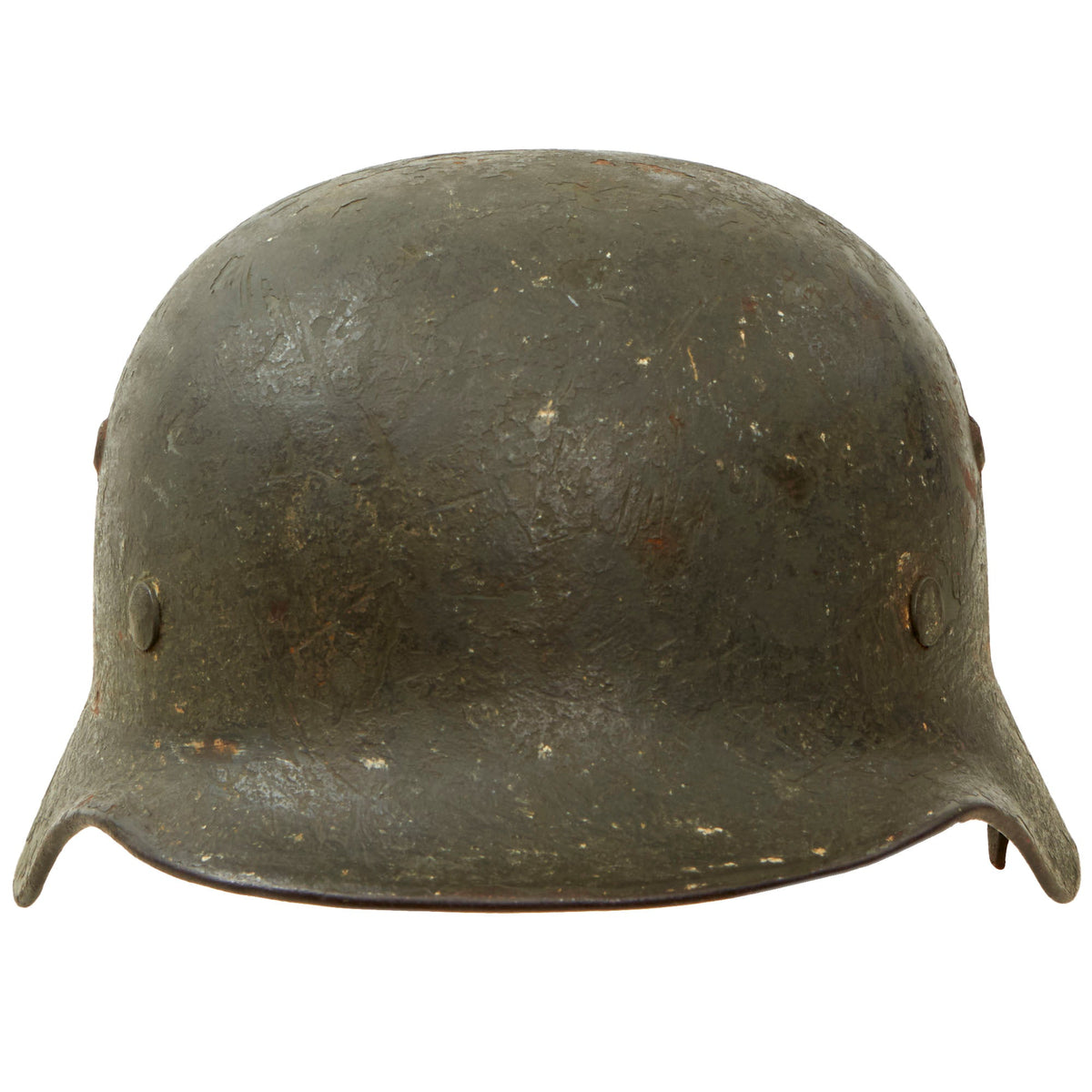Original German WWII Army Heer M35 Former Double Decal Helmet with 56cm Liner & Broken Chinstrap – EF64 Original Items
$ 650,00 $ 195,00
Original Item: Only One Available. This is a rare all original example of a German WWII Model 1935 “Double Decal” helmet, as issued to the Heer (Army). As an early war helmet, it was originally painted with early Apfelgrün (apple green) paint, which is the early war color with more green in the mix. It also was equipped with “double decals”, with a Heer Eagle on the left side and a National Colors on the right. The use of the second decal was discontinued in 1940, and in 1943 it was ordered that helmets with the national colors have them removed.
This helmet did not have the decal removed at that time, however the helmet had the exterior repainted in the field, which covered up both decals. It looks like the Eagle was replaced, but the National Colors shield was not. Over time it saw additional service, leading to a lot of wear to repainted finish on the exterior, which removed the replaced Heer decal. It may have even been repainted several times, and the liner was also replaced at some point when the interior was repainted. This is a really nice example of a service worn helmet with lots of patina!
The reverse, interior, neck guard apron is batch number stamped 2 436, and the interior, left side, apron has a stamped manufacturer’s code and size, E.F.64 indicating that indicating it was manufactured by Emaillerwerke AG, of Fulda Germany in size 64. The marking is lightly stamped, but the “Gothic” style E is definitive for Emaillerwerke, as ET used Latin style letters. We measured the outside of the shell, and with a measurement of 65cm, it is definitely a size 64. This is a nice medium size that can accommodate liners from 56cm to 57cm or US 7 to 7 1/8. Size 64 shells are harder to find and are therefore more valuable to a collector.
All three liner retaining pins are intact, with exterior paint retained on all. The helmet still has its correct excellent condition M31 liner with all of the 8 fingers present and supple, showing damage and wear consistent with service. There also looks to possibly have been some damage from insects or rodents to the leather, which is the later war “pigskin” type of leather. It has a replacement top tie string, and there is some splitting over the rim. The left exterior of the galvanized steel liner band is marked 64 n. A. / 56, indicating that it is a size 56 liner for a size 64 shell. The right side displays the full manufacture information, as well as a date, though it was stamped faintly and can be hard to read:
SCHUBERTH-WERKE K.-G.
D. R. P.
1940
BRAUNSCHWEIG
The chinstrap is present and has the correct later war galvanized steel hardware. The leather is worn and in somewhat delicate condition, and the buckle side of the chin strap has broken, torn through just to the inside of the securing stud. The buckle is still attached to the longer side of the chin strap, which is intact but cracked and worn.
Overall a very nice 100% genuine M35 Former Double Decal Heer Army helmet, that saw extensive service during WWII! The period service wear on this gives it an absolutely unique look! This is an item that will only continue to appreciate in value over time!
The first “modern” steel helmets were introduced by the French army in early 1915 and were shortly followed by the British army later that year. With plans on the drawing board, experimental helmets in the field, (“Gaede” helmet), and some captured French and British helmets the German army began tests for their own steel helmet at the Kummersdorf Proving Grounds in November, and in the field in December 1915. An acceptable pattern was developed and approved and production began at Eisen-und Hüttenwerke, AG Thale/Harz, (Iron and Foundry Works), in the spring of 1916.
These first modern M16 helmets evolved into the M18 helmets by the end of WWI. The M16 and M18 helmets remained in usage through-out the Weimar Reichswehr, (National Defence Force, Circa 1919-1933), era and on into the early years of the Third Reich until the development of the smaller, lighter M35 style helmet in June 1935.
In 1934 tests began on an improved Stahlhelm, whose design was a development of World War I models. The Eisenhüttenwerke company of Thale carried out prototype design and testing, with Dr. Friedrich Schwerd once again taking a hand.
The new helmet was pressed from sheets of molybdenum steel in several stages. The size of the flared visor and skirt was reduced, and the large projecting lugs for the obsolete armor shield were eliminated. The ventilator holes were retained, but were set in smaller hollow rivets mounted to the helmet’s shell. The edges of the shell were rolled over, creating a smooth edge along the helmet. Finally, a completely new leather suspension, or liner, was incorporated that greatly improved the helmet’s safety, adjustability, and comfort for each wearer. These improvements made the new M1935 helmet lighter, more compact, and more comfortable to wear than the previous designs.
The Army’s Supreme Command officially accepted the new helmet on June 25, 1935 and it was intended to replace all other helmets in service.
The M1935 design was slightly modified in 1940 to simplify its construction, the manufacturing process now incorporating more automated stamping methods. The principal change was to stamp the ventilator hole mounts directly onto the shell, rather than utilizing separate fittings. In other respects, the M1940 helmet was identical to the M1935. The Germans still referred to the M1940 as the M1935, while the M1940 designation were given by collectors.
The last wartime upgrade to the standard helmet took place on 6 July 1942 at the request of the Army High Command. The rolled edge found on M1935 and M1940 helmets was discontinued as a measure of economy. On 1 August 1942 the first M1942 helmets were placed into production, and this was the model produced until late in the war, when most factories were captured or stood idle due to material shortages.
Fast Shipping with Professional Packaging
Thanks to our longstanding association with UPS FedEx DHL, and other major international carriers, we are able to provide a range of shipping options. Our warehouse staff is expertly trained and will wrap your products according to our exact and precise specifications. Prior to shipping, your goods will be thoroughly examined and securely secured. We ship to thousands clients each day across multiple countries. This shows how we're dedicated to be the largest retailer on the internet. Warehouses and distribution centres can be located throughout Europe as well as the USA.
Note: Orders with more than one item will be assigned a processing date depending on the item.
Before shipping before shipping, we'll conduct a thorough inspection of the items you have ordered. Today, the majority of orders will be delivered within 48 hours. The delivery time will be between 3-7 days.
Returns
The stock is dynamic and we cannot completely manage it because multiple stakeholders are involved, including our factory and warehouse. So the actual stock may alter at any time. It's possible that you may not receive your order once the order has been made.
Our policy is valid for a period of 30 days. If you don't receive the product within 30 days, we are not able to issue a refund or an exchange.
You can only return an item if it is unused and in the same state as the day you received it. You must have the item in its original packaging.
Related products
Uncategorized
Uncategorized
Uncategorized
Uncategorized
Uncategorized
Armored Burgonet Helmet & Polearm from Scottish Castle Leith Hall Circa 1700 Original Items
Uncategorized
Uncategorized
Uncategorized
Australian WWII Owen MK1 Machine Carbine SMG Custom Fabricated Replica with Sling Original Items
Uncategorized
Uncategorized
Uncategorized
Uncategorized
Uncategorized
Uncategorized
Uncategorized
Uncategorized
Uncategorized
Uncategorized













































































